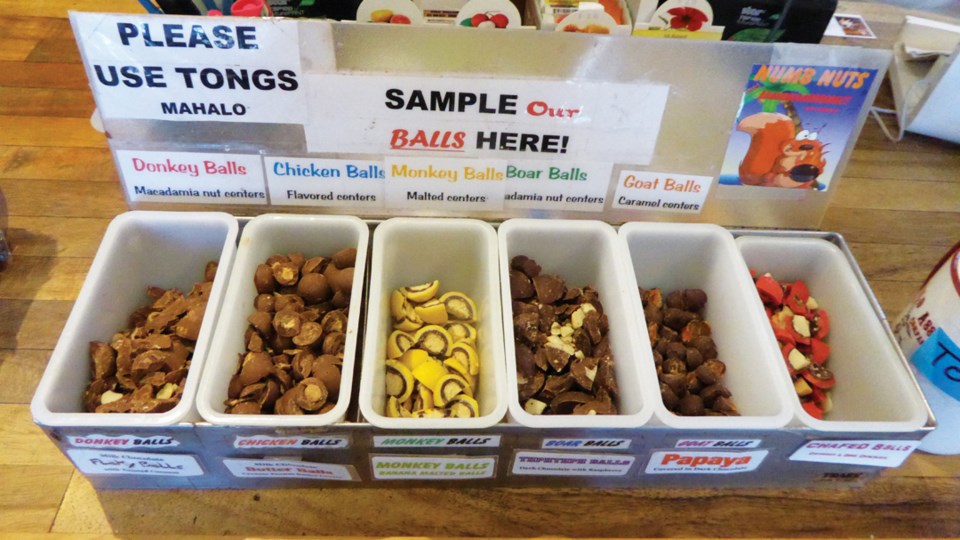While faraway Kiluea erupts, we explore Hawaii’s quiet side. Here, farmers’ markets display exotic corn-ucopias: huge avocadoes, apple bananas, extra-sweet pineapples, mangoes, strawberry papayas, exotic star fruit, scaly dragon fruit and red hairy rambutans. Tables also include tasty Maui onions, purple Molokai sweet potatoes and inviting samples of island coffees, honey, Macadamia nuts and even tropical jams. But to investigate Big Island chocolate, we head to south Kona.
The Original Hawaiian Chocolate Farm and Factory sprawls high above Keahau Bay. While munching chocolate, our tour begins under a shady banyan tree. “You’re sampling our two types of cocao beans: Fostero and Criollo,” owner Bob Cooper explains. “Notice the pure dark chocolate’s kick? Chocolate inspires thoughts of romance; cocoa’s theobromine excites the libido.”
Onward into the orchard, we sight large green, red, yellow and purple pods hanging from thick trunks and branches. “For 3,000 years Brazilian natives grew cocoa trees in the rainforest. Spanish explorers learned about processing chocolate in the 16th century,” Bob says. “In moving to Hawaii, my wife and I bought this 10-acre farm, studied chocolate production and became the only grower-processors in the U.S.
“Our cocoa trees flourish at this latitude. Though related to gardenias, their blossoms are odourless. Midge flies pollinate those tiny white flowers. Five months later, their mature red and yellow pods are hand picked to avoid self-germination. This harvest begins our six-month chocolate-making process,” notes Bob grinning. “By the way, don’t chew the leaves! They’re cocoa leaves, not coca leaves.”
Under a nearby awning, he slices open a chocolate pod, exposing a white cottony substance called the placenta. Bob explains, “This material and their purple beans ferment in that wooden sweatbox. Exothermal energy sweats the placentas off, leaving blackened beans. We then sun-dry the beans on those racks for three to four weeks.”
In an adjacent building, we learn how the beans are roasted, winnowed and conche ground. During the twenty hours of conching, emulsifiers and vanilla are added. Breathing in sweet aromas, we watch cocao butter swirling in the temperer, a hot two-foot-wide pot.
One worker pours the satiny chocolate into molds forming Plumeria flowers. Hurrying into the gift shop, we buy boxes of these dark floral treats to share with family and friends.
Just up the highway, a heritage sign heralds Donkey Balls Factory and Store. Windows display one boar’s weather report, its ropey tail pointing at the sun and a cartoon depicting a suave donkey sipping Wild Ass coffee. A sign recounts their store’s offbeat name: Once donkeys transported burlap bags of Macadamia nuts to the factory. Workers laughingly called the nuts donkey balls. Their artisan products were given the same funny, naughty name.
The manager welcomes us with samples of these and other oddly dubbed balls. Through a glass window we watch a tumbler spin chocolates over Mac-nuts. When the owner arrives, he shows us a ten-pound bar of Belgium-style Guittard chocolate, a premium chocolate used to create 21 types of Donkey…and Boar Balls. He proudly grins. “Adding flavourings and changing the tasty core, we’ve concocted 119 types of tumbled treats.”
Shelves overflow with unique island products. Mischievous cartoon-like critters decorate their packages. Their ingredients also sound appealing. Monkey Balls contain a choice of eight tropical fruits covering malted centres. Goat Balls offer caramel centres coated with one of six exotic flavours. Chicken Balls provide small Mac-nuts coated with either “flutterscotch” or “peepermint.”
Being past Christmas, we ignore the Rudolph Red Noses and instead buy minty green Leprechaun Balls for St. Patrick’s Day. Stowing those wee treats in the trunk with Hawaiian Farm chocolates, our foodie tour ends in sweet triumph.
If you go, check out Hawaiian Chocolate Farm and Factory at www.ohcf.us. To experience the Donkey Ball Store, see www.donkeyballstore.com



